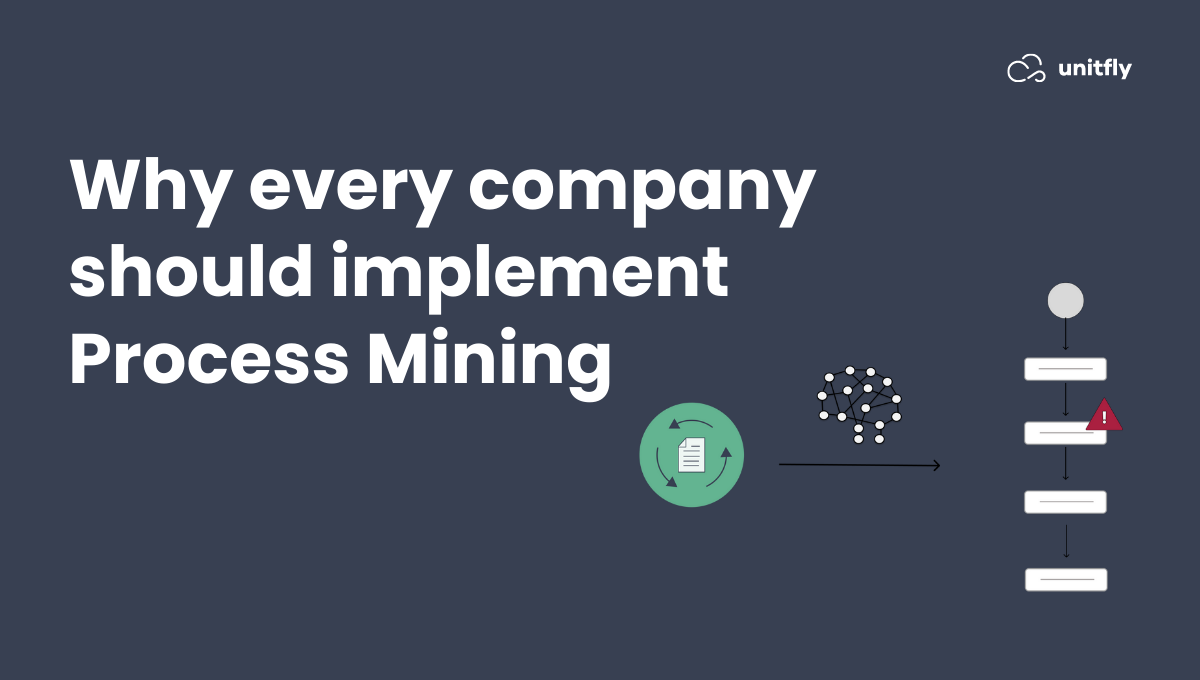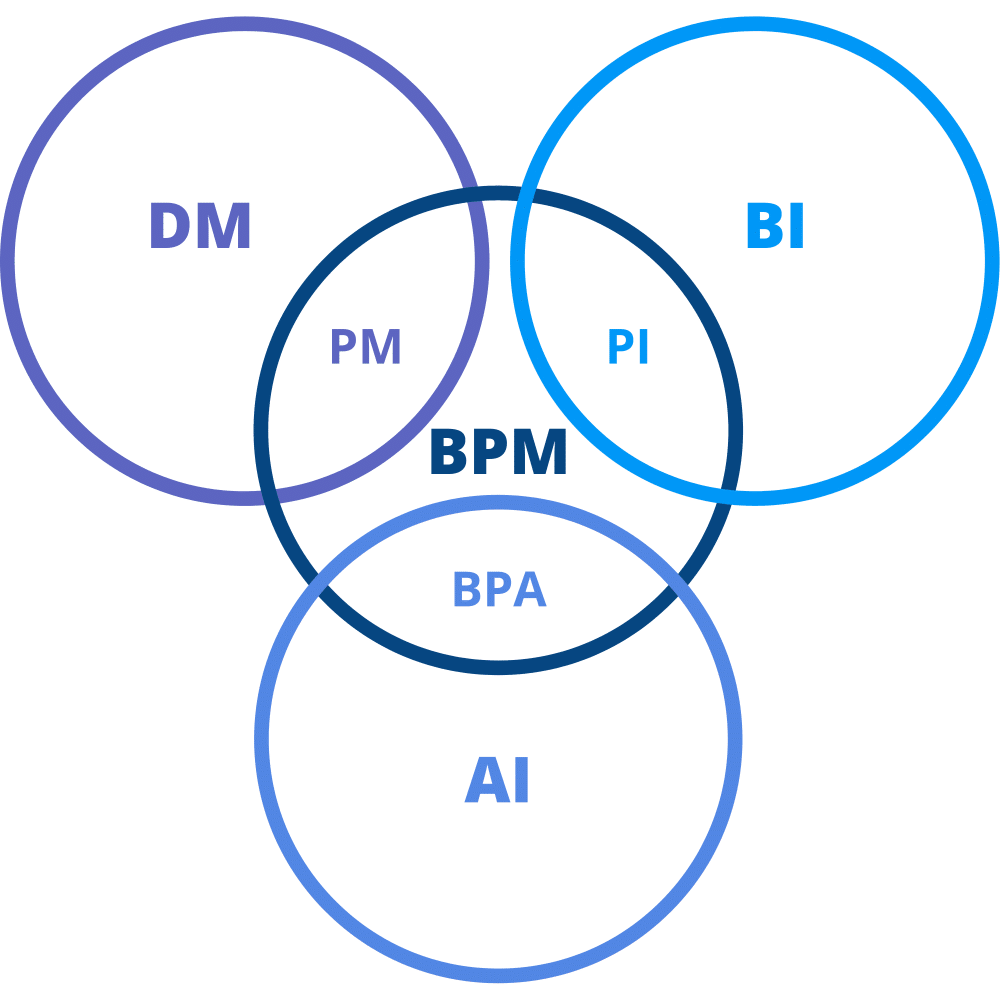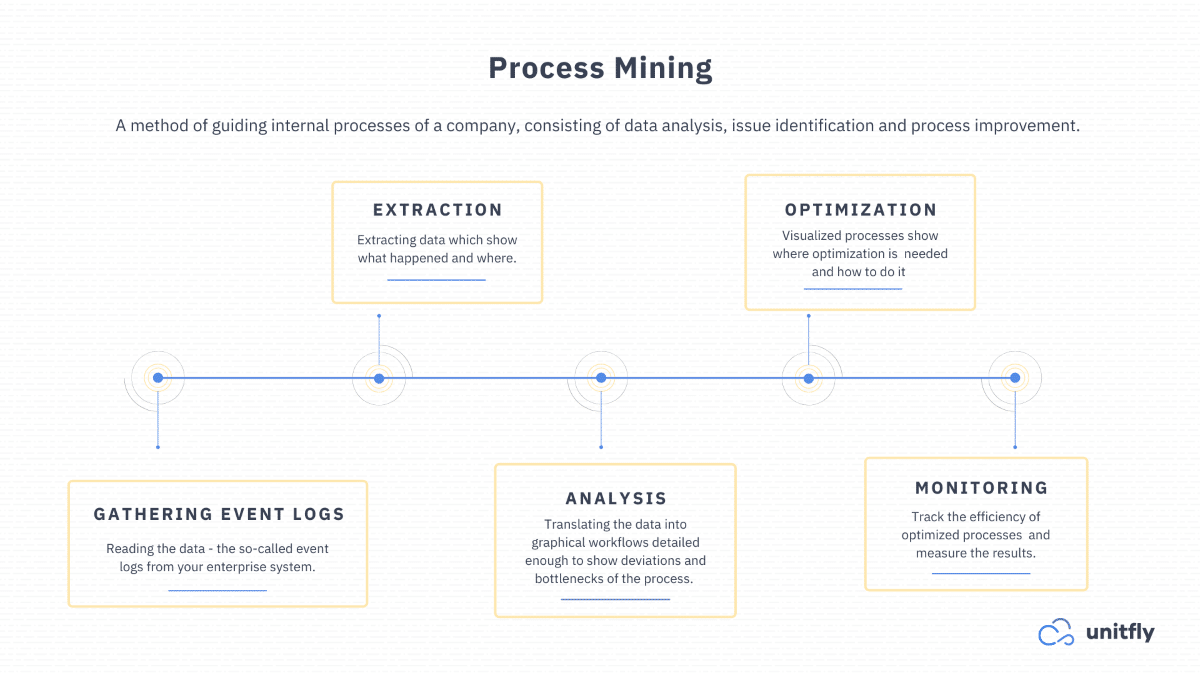
Why every company should implement Process Mining
Key points:
- Process Mining is a method of analyzing process behavior and the situation between every event
- The technique aims to understand the relations between events, how they affect each other and what are their strengths/weaknesses
- Process Mining provides knowledge of what valuable advantages and crucial drawbacks of a process are
- Based on event logs, Process Mining can easily understand a process and its behavior
Why do we need Process Mining
People and organizations are surrounded by various processes on a daily basis. These processes are incorporated in every domain a person can imagine, from patient reception in a hospital, to customer claims. Most of us are not aware of it, but a majority of organizations such as post offices, governmental institutions, and businesses rely heavily on their processes.
Without structured workflows that define roles, responsibilities, milestones, and increments, the results of work would be expensive, and unproductive.
There is an constant need to improve and support business processes in today’s competitive and rapidly changing environments. Therefore, business processes need to be well-defined and maintained regularly.
The easiest way to understand the necessity of processes is that the quality of the process is in direct correlation with minimized risk, cost, and time, while the effectiveness is growing.
Because processes are so crucial, it is essential to understand that entropy affects them; they gradually decay due to the changes in their working environment. Therefore, it is necessary to readjust workflows according to the situation and objectives.
With the rapid technological development, processes became more valuable, and, luckily, easier to monitor and analyze. And with this comes the challenge of exploiting data in a meaningful way – to provide insights, identify bottlenecks, anticipate problems, record policy violations, recommend countermeasures, and streamline processes. Process Mining aims to do exactly that.
What is Process Mining
Process Mining (PM) is an emerging discipline that aims to provide fact-based insights and to support process improvements. It emerged out of Business Process Management (BPM) as a logical progress of combining Computer Science with Process Management.
By combining Data Mining and Business Process Management, data gathered from user interaction gets its meaning and purpose.

Process Mining is an intersection between Data Mining and Business Process Management. In fact, it is the “missing link” between Data Mining and traditional model-driven BPM. While Data Mining provides a development perspective with algorithms that analyze event logs, BPM serves as an analytical perspective for processes that recognizes bottlenecks and provides solutions, such as optimization and monitoring. By combining both approaches, gathered data gets its meaning and purpose.
The goal of Process Mining is to use event data to draw out process related information, e.g., to automatically discover a process model by observing events recorded by some system or to check the conformance of a given model by comparing it with reality. Process mining techniques are able to extract knowledge from event logs commonly available in today’s information systems. Therefore, these techniques provide new means to discover, monitor, and improve processes in a variety of fields.
What is an Event Log
In order to use Process Mining techniques to analyze and monitor specific processes, first we need data. Process Mining data are called Event Logs, and they contain a set of events that refer to the particular process.
Every Event Log file contains:
- timestamp or any form of date and time notation (to know when the specific action or event occurred)
- event name (to identify which specific event happened)
- case ID (to identify the timeline in which the event occurred)
Since the process repeats for immense number of times, case ID defines which specific timeline the event occurred.
Now, with this information, we are ready to analyze a process, its timelines and events. It is crucial to discuss and arrange the data requirement before the Process Mining analysis starts. The reason for such is mostly because of information collision and shortage with introducing or excluding specific attributes to/from the Event Log.
Additionally, many other attributes can provide more information about the process.
Analyze the efficiency of your employees
One of the great examples are users, for which we get another vital dimension to analyze. By providing which user interacted in specific events, we can then analyze employee’ efficiency, monitor their progress, and get insights on whether they complete tasks in the critical period. Another attribute is cost, which allows us to analyze the funds an organization spends for a specific process, and the optimized process results in cost reduction.
Five Stages of Process Mining
Here are five most important stages of Process Mining:
- Gathering event logs
- Data extraction
- Analyzing cases
- Optimization
- Monitoring

Process Mining Benefits
The most important reason why Process Mining is rapidly becoming popular among various organizations is because of the benefits that it provides. Firstly, we get a detailed understanding of a process that we are interested in. Second, Process Mining allows analysis of the process so that the organization can see the overall performance of the process and the performance of users included in the process.
From the results of the analysis, we can make decisions for improvement and optimization. This means that Process Mining allows both analysis and adjustment of the process, which results in an updated process that has better performance than earlier.
Time, Cost, Quality, Efficiency and Risk – crucial performance metrics for Process Mining
After the process has been analyzed and optimized, we can expect that the time for the process to be completed would decrease. Cost would also go down since we spend less time in the process, and risk is reduced since we have knowledge of potential bottlenecks that are being solved. Furthermore, quality of increment that results from the process can be improved, and efficiency increased since we take less time to complete the process.
Takeaway
Process Mining is an method of analyzing process behaviour with a goal of understanding the relations between events, how they affect each other, as well as their strengths and weaknesses. As a result, it gives us the knowledge of valuable information we can leverage and the knowledge of crucial drawbacks of a process we can eliminate.
ABBYY Flexicapture is a leading Process Mining and Process Intelligence platform designed to help organizations discover how current processes work, identify bottlenecks, point out the possibilities of optimization and predict future outcomes by following these steps:
- ABBYY Timeline creates a “digital twin” of the event data from different systems
- Analyzes the performance of processes
- Monitors process behaviors in real time
- Conducts AI/ML-based predictive analytics to allow users to identify the outcome or performance of any process case in the early stages of the process execution
Are you ready to improve your processes and increase your business process efficiency? Let’s talk!
References:
Dumas, M., La Rosa, M., Mendling, J., & Reijers, H. A. (2013). Fundamentals of business process management (Vol. 1, p. 2). Heidelberg: Springer.
Van Der Aalst, W., Adriansyah, A., De Medeiros, A. K. A., Arcieri, F., Baier, T., Blickle, T., … & Wynn, M. (2011, August). Process mining manifesto. In International Conference on Business Process Management Springer, Berlin, Heidelberg.
Van Der Aalst, W. M. (2011, April). Process mining: discovering and improving Spaghetti and Lasagna processes. In 2011 IEEE Symposium on Computational Intelligence and Data Mining (CIDM) IEEE.



